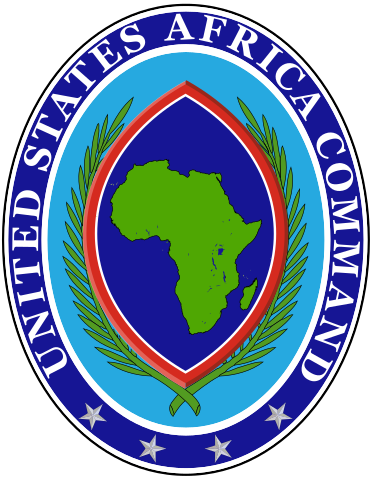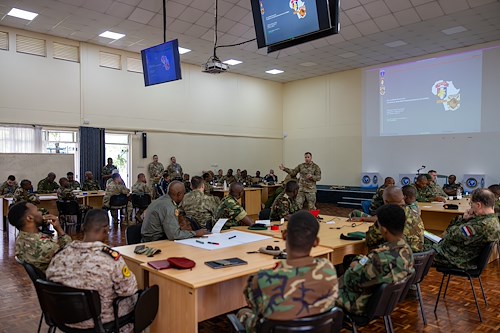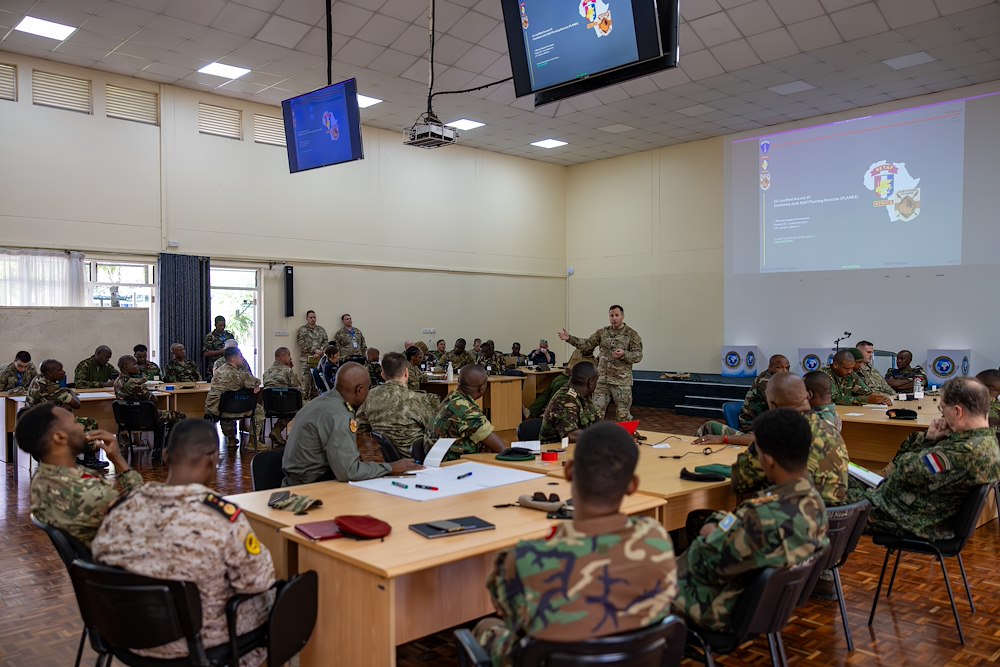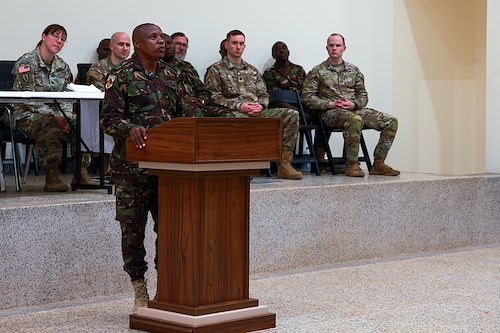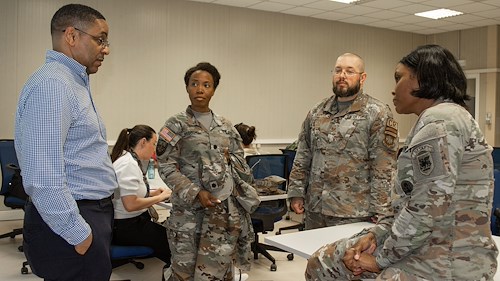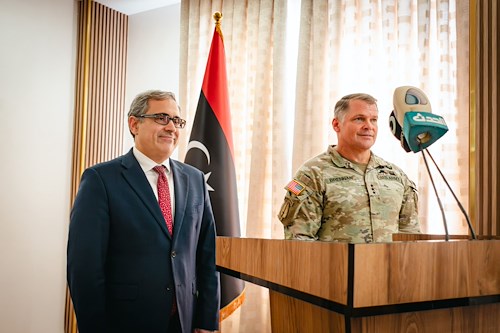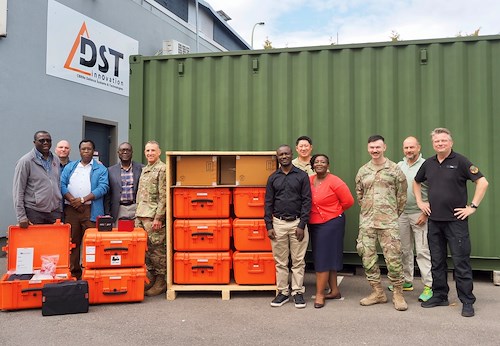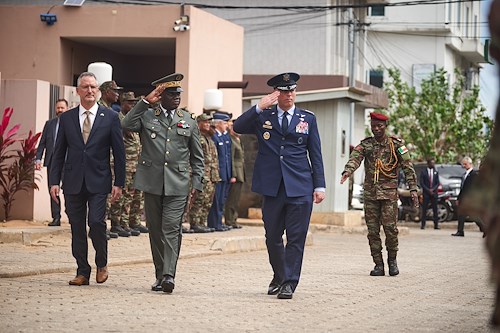Gallery contains 6 images
×
Photo 1 of 6
U.S. Army Southern European Task
U.S. Army Lt. Col. Justin Belford, an exercise planner with 7th Mission Support Command, introduces key planning concepts to participants of exercise Justified Accord 2025 (JA25) at the Humanitarian Peace Support School in Nairobi, Kenya, Feb. 10, 2025. The introduction session set the stage for multinational collaboration ahead of the official opening ceremony. JA25 is the premier U.S. Africa Command (USAFRICOM) exercise in East Africa, designed to enhance multinational combat readiness, strengthen crisis response capabilities and empower allies and partners in the region. Led by U.S. Army Southern European Task Force, Africa (SETAF-AF) and hosted in Kenya, Djibouti and Tanzania, JA25 integrates high-intensity training scenarios that sharpen warfighting skills, increase operational reach and enhance the ability to execute complex joint and multinational operations. The exercise runs from Feb. 10–21, 2025.
(U.S. Army photo by Sgt. 1st Class Solomon Navarro)
Photo by: Sgt. 1st Class Solomon Navarro
Photo 2 of 6
U.S. Army Southern European Task
U.S. Army Lt. Col. Trish Basile, Chief of the Kenya United States Liaison Office (KUSLO), and Col. Jonathan Rungwe, Commandant of the Humanitarian Peace Support School (HPSS), welcome a Swiss service member with a handshake during the opening ceremony of Exercise Justified Accord 2025 (JA25) at HPSS in Nairobi, Kenya, Feb. 10, 2025. JA25 is the premier U.S. Africa Command (USAFRICOM) exercise in East Africa, designed to enhance multinational combat readiness, strengthen crisis response capabilities and empower allies and partners in the region. Led by U.S. Army Southern European Task Force, Africa (SETAF-AF) and hosted in Kenya, Djibouti and Tanzania, JA25 integrates high-intensity training scenarios that sharpen warfighting skills, increase operational reach and enhance the ability to execute complex joint and multinational operations. The exercise runs from Feb. 10–21, 2025. (U.S. Army photo Sgt. 1st Class Solomon Navarro)
Photo by: Sgt. 1st Class Solomon Navarro
Photo 3 of 6
U.S. Army Southern European Task
Kenya Defence Forces (KDF) Brig. William Kamoiro, KDF exercise director for Justified Accord 2025 (JA25), addresses multinational partners during JA25 at the Counter Insurgency Terrorism and Stability Operations Center in Nanyuki, Kenya, Feb. 11, 2025. JA25 is the premier U.S. Africa Command (USAFRICOM) exercise in East Africa, designed to enhance multinational combat readiness, strengthen crisis response capabilities and empower allies and partners in the region. Led by U.S. Army Southern European Task Force, Africa (SETAF-AF) and hosted in Kenya, Djibouti and Tanzania, JA25 integrates high-intensity training scenarios that sharpen warfighting skills, increase operational reach and enhance the ability to execute complex joint and multinational operations. The exercise runs from Feb. 10–21, 2025. (U.S. Army photo by Sgt. Kylejian Francia)
Photo by: Sgt. Kylejian Francia
Photo 4 of 6
U.S. Army Southern European Task
Kenya Defence Forces (KDF) Brigadier Gen. Paul Koech, chief of training at Kenya Defence Headquarters, formally opens exercise Justified Accord 2025 (JA25) by signing a proclamation at the Humanitarian Peace Support School (HPSS) in Nairobi, Kenya, Feb. 10, 2025. U.S. Army Lt. Col. Trish Basile, chief of the Kenya U.S. Liaison Office (KUSLO), and KDF Col. John Rongoei, commandant of HPSS, stand together as witnesses during the signing ceremony at HPSS. JA25 is the premier U.S. Africa Command (USAFRICOM) exercise in East Africa, designed to enhance multinational combat readiness, strengthen crisis response capabilities and empower allies and partners in the region. Led by U.S. Army Southern European Task Force, Africa (SETAF-AF) and hosted in Kenya, Djibouti and Tanzania, JA25 integrates high-intensity training scenarios that sharpen warfighting skills, increase operational reach and enhance the ability to execute complex joint and multinational operations. The exercise runs from Feb. 10–21, 2025. (U.S. Army photo by Sgt. 1st Class Solomon Navarro)
Photo by: Sgt. 1st Class Solomon Navarro
Photo 5 of 6
U.S. Army Southern European Task
Forrest McKinley, exercises contractor for U.S. Army Southern European Task Force, Africa (SETAF-AF), speaks U.S. Army Lt. Col. Reneka Redmond, left, division chief of Rule of Law, SETAF-AF, U.S. Army Maj. Teisha Barnes, SETAF-AF civil affairs officer with Civil Military Operations (G39, CMO), and U.S. Air Force Tech. Sgt. Robert Knipfer, a gender focal point with the 818th Mobility Support Advisory Squadron, 621st Contingency Response Wing, during the initial planning event for exercise Justified Accord 2025 (JA25) in Vicenza, Italy, Jun. 11, 2024. JA25 is U.S. Africa Command's largest exercise in East Africa, running from Feb. 10-21, 2025. Led by U.S. Army Southern European Task Force, Africa (SETAF-AF), and hosted in Kenya, this year's exercise incorporates personnel and units from over 20 nations. JA25 builds readiness for the U.S. joint force, prepares regional partners for UN and AU mandated missions, and increases multinational interoperability in support of humanitarian assistance, disaster response and crisis response. (U.S. Army photo by Maj. Joe Legros)
Photo by: Maj. Joe Legros
Photo 6 of 6
U.S. Army Southern European Task
U.S. Army Lt. Col. Reneka Redmond, right, division chief of Rule of Law, U.S. Army Southern European Task Force, Africa (SETAF-AF), and U.S. Air Force Tech. Sgt. Robert Knipfer, a gender focal point with the 818th Mobility Support Advisory Squadron, 621st Contingency Response Wing, show off their unit patches during the initial planning event for exercise Justified Accord 2025 (JA25) in Vicenza, Italy, Jun. 11, 2024. JA25 is U.S. Africa Command's largest exercise in East Africa, running from Feb. 10-21, 2025. Led by SETAF-AF, and hosted in Kenya, this year's exercise incorporates personnel and units from over 20 nations. JA25 builds readiness for the U.S. joint force, prepares regional partners for UN and AU mandated missions, and increases multinational interoperability in support of humanitarian assistance, disaster response and crisis response. (U.S. Army photo by Maj. Joe Legros)
Photo by: Maj. Joe Legros
NAIROBI, Kenya -- Among the flurry of tactical live-fires and squad movement drills, air-ground integration and the humanitarian initiatives at exercise Justified Accord 2025 (JA25), lies the one thing those who serve in any armed forces must follow: The Law.
The Law of Armed Conflict, or LOAC, is a key aspect of training for any military. JA25’s academics course aimed at learning from the international legal lessons of previous wars in an effort to reduce the amount of human suffering in future conflicts.
“The soldier’s rules are a broad set of rules that we have pulled from the large breadth of international law,” said U.S. Army Maj. Tim Olliges, an operational law attorney assigned to U.S. Army Southern European Task Force, Africa (SETAF-AF), the lead U.S. Army command and planner of JA25. “The LOAC is extensive and can be complex, so we pull out the ten most critical concepts that every soldier, right down to the private, should know before they go into combat.”
JA25 is the premier U.S. Africa Command (USAFRICOM) exercise in East Africa, designed to enhance readiness, strengthen crisis response capabilities and empower allies and partners in the region. Led by SETAF-AF and hosted by Kenya, Djibouti and Tanzania, JA25 integrated high-intensity training scenarios that sharpen warfighting skills, increase operational reach and enhance the ability to execute complex joint and multinational operations.
The U.S. Army created the following 10 basic, easy to understand, rules for soldiers at all levels to know their responsibilities when in combat:
1) Soldiers fight only combatants.
2) Soldiers do not harm enemies who surrender. They disarm them and turn them over to their superior.
3) Soldiers do not kill or torture personnel in their custody.
4) Soldiers collect and care for the wounded, whether friend or foe.
5) Soldiers do not attack protected persons and protected places.
6) Soldiers destroy no more than the mission requires.
7) Soldiers treat civilians humanely.
8) Soldiers do not steal. Soldiers respect private property and possessions.
9) Soldiers should do their best to prevent violations of LOAC.
10) Soldiers report all violations of LOAC to their superiors.
“These may seem simple, and they are, but they are also incredibly important. They’ve been written to be understood by diverse audiences with different education levels, different languages or different backgrounds,” said Olliges. “We use these not just for training in Africa, but also for soldiers in the U.S. Army.”
All service members are held accountable for illegal actions, not just commanders. Therefore, all are required to learn and understand the rules of war and how they can ensure they remain effective fighting forces, all while remaining within the bounds of the law.
“USAFRICOM has prioritized including this training at its exercises and other security cooperation events with our partners on the continent,” said Olliges. “We want to ensure each person trained to fight is also trained on their legal obligations.”
While the 10 rules are straightforward, the training goes further, breaking down what each rule means, offering explanations as to why the rules exist and articulating what happens if they break the law of armed conflict.
“I don’t use examples from other nations or even what may have happened here in Africa in the past, but of our own U.S. service members and what happened to them when they broke the law in combat,” said Olliges. “We have our share of soldiers, sailors, marines, and airmen who have forgotten or disregarded these rules. I share anecdotes and stories about what happened, how they were prosecuted and the negative impact their actions had on our military operations.”
The LOAC training also included how legal officers play a significant role in combat operations.
“Aside from the basics every soldier must know, we also provide counsel on how to plan operations within the country’s legal framework,” said Olliges. “In this case, I’m working with my Kenyan counterparts to integrate legal advice based on Kenyan and international law into the staff process. This includes what their commander needs to consider before determining a course of action.”
In the U.S., as well as many other nations, there are specific laws about what a military can do within or beyond its borders, as well as who has the authority to give certain orders. Some decisions can only be made at presidential levels, while others can be delegated down to commanders in the field.
“Our laws are different from the U.S.,” said KDF Maj. David Musyoka, a legal advisor and participant in the LOAC course. “But we share a common duty as legal officers to advise our commanders on what they are permitted or not permitted to do regarding the use of force, deployment in support of civilian authorities and other operations.”
Legal officers are generally involved in every aspect of mission planning.
“We all know most plans don’t survive first contact,” said Musyoka. “That is why it’s important to understand the mission and provide a clear picture of the legal ramifications if certain events happen on the battlefield, or if certain decisions are made as the plan changes in real time.”
From the initial assessment of an objective, to various courses of action and wargaming, legal officers review each movement and decision point, providing valuable data to the commander. These decisions are based on higher headquarters guidance or dynamic events.
“Understanding our legal obligations, from the 10 rules we give to all soldiers, to our involvement in planning missions, is key for all warfighters,” said Olliges. “Everyone has a role in knowing what they can do legally when it comes to their participation in armed conflict.”
(Courtesy article by U.S. Africa Command's Pat Foughty)
